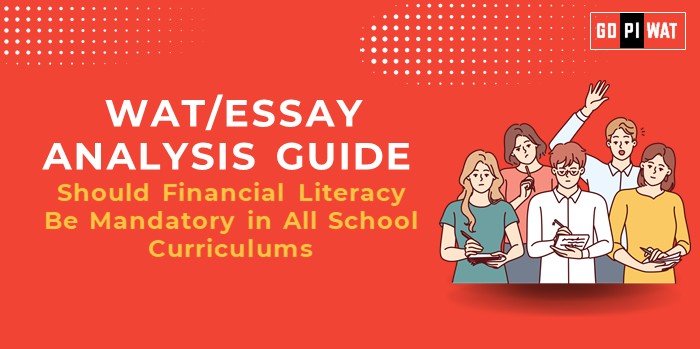📋 WAT/Essay Guide: Should Financial Literacy Be Mandatory in All School Curriculums?
🌟 Understanding the Topic’s Importance
Financial literacy is crucial for fostering informed citizens capable of managing personal finances effectively. Its inclusion in school curriculums aligns with broader economic and social empowerment goals.
📝 Effective Planning and Writing
Reading & Planning: 5 minutes | Writing: 20 minutes | Review: 5 minutes
Preparation Tips:
- 💡 Gather data points on financial literacy rates and education models.
- 🤝 Note stakeholders and their respective roles.
💡 Introduction Techniques
1. Contrast Approach: “While India is an emerging economic power, its low financial literacy rate of 27% hampers inclusive growth, necessitating curriculum reforms.”
2. Solution-Based: “Mandatory financial literacy in schools is a proactive measure to bridge economic and educational gaps, equipping students for real-world challenges.”
📚 Structuring the Essay Body
- 🏆 Achievements: Highlight the role of financial education in reducing personal debt and improving savings behavior. Include case studies like Kerala’s successful implementation and Canada’s positive outcomes.
- ⚖️ Challenges with Comparative Analysis: Mention resource constraints and compare them with best practices from countries like Australia.
- 🔮 Future Outlook: Emphasize potential benefits like improved GDP and economic resilience with universal implementation.
🔗 Concluding Effectively
1. Balanced Perspective: “While introducing financial literacy in schools is essential, its success depends on careful planning, inclusive policies, and sufficient resource allocation.”
2. Global Comparison: “India can draw inspiration from countries like Singapore and New Zealand to integrate financial literacy into its curriculum effectively.”
✍️ Sample Short Essays
1. Balanced Perspective:
“Mandatory financial literacy is not merely an educational reform but a societal necessity. It equips students with practical life skills while contributing to broader economic stability.”
2. Solution-Oriented:
“Integrating financial literacy through practical modules, interactive platforms, and teacher training can transform India’s education system into a global benchmark.”
3. Global Comparison:
“India’s low financial literacy rate demands urgent action. By adopting successful international models, it can prepare future generations for financial independence and growth.”


